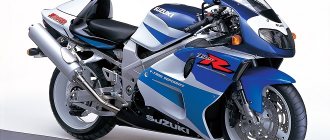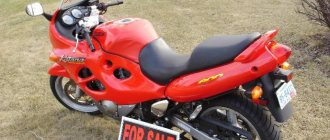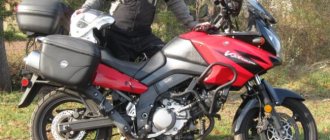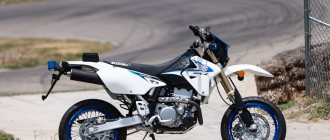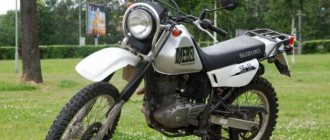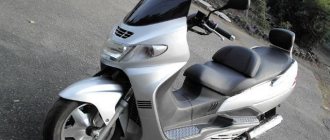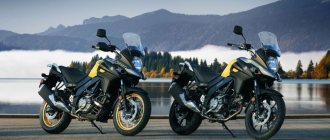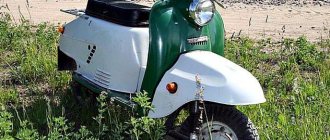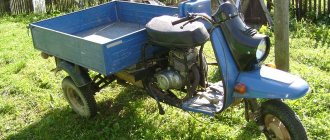Suzuki DL650 V-Strom
There are two versions of the DL V-Strom: with a 650 cc and a 1000 cc V-twin. Both engines are from the family of popular SV roadsters (originally the great and terrible “liter” twin, about which Hollywood is just right to make trash horror films, an injection “deuce” with character - was developed for the hellish TL1000S and R sportbikes). Of course, the 1000 cc modification of the V-Strom is more popular: of course, “after all, it’s a LITER, and not some little thing that a self-respecting motorcyclist won’t even look at.” So, dear glamorous liter drinkers, I hasten to disappoint you: the 650 cc model is a better “tourist” than the V-Strom 1000. And without options, appeals and discussions: accept this as a fact.
Modifications
There are two official modifications for the motorcycle. The first one appeared in 2007. Stock ABS appeared on the bike . The modification was called Suzuki V-Strom DL650A. It was marked by the transition to 2 spark plugs per cylinder (previously there was one, according to tradition).
Suzuki V-Strom 650 XT
The V-Strom 650 XT modification featured spoked wheels and a front beak.
The second modification was born in 2015 .
- The main differences were the spoked wheels and the predatory “beak” that some pit bikes have.
- But they also began to install a digital instrument panel on the model, although the tachometer on it remained a cup-shaped, analogue one.
- In addition to speed, the gear indicator, fuel level, and mileage meter have become digital.
In 2021, the model is changing again, although they did not call it a separate modification. The appearance of the new development almost completely repeated its aging brother - the liter motorcycle.
Suzuki DL650 V-Strom
Suzuki DL650 V-Strom
Suzuki DL650 V-Strom
Externally, the DL V-Strom 1000 and 650 are almost identical. You can distinguish a big one from a small one by the lower “plough”, a large motor and a couple of other signs. But what a difference you can feel behind the wheel! As good as the “liter” device is on a straight line, the 650 is great in sharp turns. The difference of 14 kilograms between the modifications is especially noticeable in traffic jams, on steep climbs and on dirt roads. The same as the “weight difference” of 31 liters. With. The 650cc V-twin with fuel injection and dual overhead camshafts is, in my opinion, one of the most successful Suzuki engines. Compact, economical, revvy and quite productive, this versatile motor has all the qualities of a good powerplant for touring enduro. 67 l. With. for 650 cubic meters - not much by modern standards. But keep in mind that the “horses” of the “V-twin” breed are different from the “in-line four” breed: the former work under tension, completely investing themselves in the “collar”, and the second “herd” has the character of a mustang - just let them run after the fillies.
Specifications
The engine is a liquid-cooled 2-cylinder composite alloy block.
The engine is based on the model installed on the SV650. But, the new version received different camshafts , crankshaft and exhaust system . It was further reconfigured and traction was added throughout the entire range.
The main difference from the prototype was the cylinder block . Instead of cast iron, a composite alloy SCEM (Suzuki Composite Electro-chemical Material) was used for its production - our own patented invention. Thanks to this, the block becomes lighter, stronger, and less thermally conductive.
Since 2012, they began to install SDTV (Suzuki Dual Throttle Valve) - a dual throttle valve control system. The principle boils down to the fact that one is controlled by the throttle, the second by electronics, triggering when the engine reaches a certain speed.
In the SDTV system, each throttle cylinder has two throttle valves.
Otherwise, this is a standard 2-cylinder unit with an L-shaped ( V-shape tilted on its side ) pistons arrangement:
- working volume - 645 cm3;
- number of cylinders - 2;
- number of cycles - 4;
- number of valves - 8, 4 per cylinder;
- power - 63.5 hp (71);
- torque - 55 Nm (62);
- cooling - liquid;
- fuel supply - injector;
- ignition - transistor (TDI);
- start - electric starter;
- tank volume - 22 (20) l.
In the process of evolution, the power and torque have changed somewhat - the figures for the latest editions are in brackets.
Suzuki DL650 V-Strom
The speedometer marking in miles is a residual feature of the US Army version of the V-Strom.
The speedometer marking in miles is a residual feature of the US Army version of the V-Strom.
Suzuki's little twin can be considered highly boosted. Let's say the 700 cc engine of the new Honda Transalp has only 60 hp. With. The power of the 650 is enough to confidently drag a pilot, a passenger and a full set of hard luggage cases filled with all sorts of coffee grinders, a down pillow and a folding stool with a soft ottoman. It is to drag, and not to rush forward, to lift the front wheel and accelerate like a whirlwind after 160 km/h with all the belongings and a passenger stupefied with horror. If you like this type of motorcycle touring, go and saddle up the VStrom 1000, or even better, the Suzuki GSXR1000.
Suzuki DL650 V-Strom
When braking, do not block the rear wheel.
When braking, do not block the rear wheel.
DL 650 is for calm, practical people, not “street trucks” and other punks. There are two things that can frustrate a picky motorcyclist. First: the 650 cc twin is a rather noisy engine; it produces a cacaphony of sounds while driving. A prolonged creaking, hysterical squeals, metallic clanging and even a quiet buzzing - all this will accompany you for thousands of kilometers of long-distance travel, even in Africa, even in Siberia. You won't get bored. There are two reasons why the VStrom engine is so loud: the design features and, most importantly, the amazing wind protection of the DL650, behind which, like behind a stone wall, the pilot is protected from the oncoming air flow and, accordingly, from the usual whistle of the helmet. In the vacuum created behind the high windshield, you can even hear the buzzing of the fuel pump!
Suzuki DL650 V-Strom
The rebound damping of the rear shock absorber is adjusted by an elegant valve.
The rebound damping of the rear shock absorber is adjusted by an elegant valve.
And here’s what else will upset the inquisitive biker: the reluctance of the motorcycle to accelerate dynamically after 130–140 km/h (especially with a passenger and luggage). Which in itself, of course, is not criminal - after all, this is not a dragster, but a “tourist”. But when overtaking cars, the sluggishness of the engine after 6500 rpm is a little annoying. The six-speed gearbox for a touring motorcycle is an advantage (the last gearbox stage is energy-saving). But the difficulty and noise with which this unit works is a big minus. I haven’t seen a gearbox as good as this one for a long time (except perhaps on a VMax of some hairy year of manufacture). The lever travel is excessively stretched and harsh, and gears are sometimes engaged with such a clanging sound that it sounds like nails are stuck between the gears. It’s difficult to catch neutral: if you catch it while standing still, you’ll hit it the third or fourth time. On the go - from the second. I wouldn’t dare to call the suspensions of the 650th VStrom energy-intensive in the fullness of this concept, and the possibilities of adjustments are a crying shame.
One of the main events of the 2014 season for me was the purchase of a new bike. The dream motorcycle is a great tourist: moderately powerful, but economical, beautiful, reliable and comfortable. However, in the few months (and 6 thousand kilometers) that I have owned it, I have managed not only to enjoy its advantages, but also to encounter some disadvantages. I tried to fit the purchase history, operating notes, minor repair problems and a list of necessary tuning into the post under the cut. Welcome to my review of the 2014 Suzuki DL650A V-Strom . Briefly about the main thing. So, who do you need to be to want a V-Strom? Despite the fact that Suzuki (as stated on the official dealer’s website) positions this bike as “one of the best motorcycles for the city,” I would not recommend this motorcycle to a typical city motorcyclist with typical “home-work-mountain-home” routes. . Why? Yes, because I am a former nakedkid owner. Yes, Ström has good traction at the bottom, feels quite confident in the aisles and has a moderate appetite, but... why do we need a motorcycle? For fun, of course! Of course, you can have a fun start from a traffic light or dashingly embroider along the Moscow Ring Road on Gold, but that’s not what it was created for. So is the V-Strom. His path is free, leisurely and comfortable riding. And the city can only allow this late in the evening. Whether it's country roads or intercity highways! Therefore, to buy Ström you need to be a bit of a tourist , and a tourist who likes to drive leisurely, otherwise, look at sports tours.
The price of a new (new Japanese, yes) tourist, the ease of periodic maintenance, the availability and prices of consumables, as well as a moderate appetite (but more on that below) tell us that this bike will please the average motorcyclist in terms of budget. Therefore, if you are a little bit Jewish and want something both cheap and cheerful, take it. However, if you are planning to constantly get serviced by officials or periodically drop your motorcycle, then Suzuki is definitely not the best option. Because when my inner Jew saw the prices for undergoing maintenance (and then for new plastic) ... in general, let’s not talk about the sad things. Important addition! The paragraph above was written before the tragic events with the collapse of the ruble. At that time, the dollar exchange rate was about 35 rubles, so now, I’m afraid, the price of a bike and consumables will no longer please the average motorcyclist...
Given the vegetable character and the overall softness and smoothness of the motorcycle, I can confidently say that to buy a V-Strom you need to be a calm person . If you like to fry for all your money, ride on the back, and in general you are no worse than Rossi, only the legs would be longer and the bike would be cooler - take anything, but not this motorcycle. I warned.
And of course, I can’t keep silent about the requirements for a rider. Yes, yes, if you are planning to take the V-Strom, then you just need to stand in front of the mirror and make sure that you do not look like Bilbo Baggins. I am almost 190 cm tall and I feel comfortable on the bike. But if the height, say, is less than 175, then I would think about it. At the very least, about buying a lowering (are there such for Ström?) tuning. This is all subjective, of course, but I think that for this motorcycle you need to be tall . Still don't believe what I say about growth? 188 centimeters, I guarantee it!
So, my dear calm, long-legged Jewish tourist , have you made your choice and saved up 400,500,500,000 rubles? Well, let's go to the salon!
They greet you by their clothes. Let's start with the appearance. There is nothing particularly to blame the Suzuki designers for here. The voluminous shape, suspension height and windshield make the Ström stand out from most average bikes: it looks impressive. In addition to this, the smooth lines of the swollen plastic parts give me strong associations with a large ship. And its behavior on the road also makes you think that you are driving a miniature two-wheeled cruise liner. Huge headlights give the appearance a certain surprised (“Oh my God, I’m a motorcycle!”) look that looks, well, funny. The color of the bike does not make it stand out from the general stream of cars, and this is also one of the reasons why, in general, I would describe the appearance of the motorcycle with the phrase “nothing extra.” Everything is neat, everything is beautiful, everything is harmonious, but... let the slippers fly at me, but I will say that there is no zest in the motorcycle. And now especially heavy sneakers will fly at me: from a design point of view, I liked my previous Stels much more.
And instead of a heart... Ström's motor is one of the main advantages of a motorcycle. Its resource became one of the key parameters for me when choosing a new bike. On some examples, with a mileage of over 70 thousand, people never even adjusted the valves. Yes, to be honest, the power is 69 hp. 645 cubic meters of working volume is really not enough. However, this is more than compensated by the good low end, tolerance to fuel quality and very moderate appetites when absorbing it.
The torque in the lower rev range is quite sufficient for the bike to idle without jerking (in first gear, of course), and it also allows you to more confidently overcome problem areas on roads with poor surfaces - it is much easier to stall on high-speed engines. In addition, if desired, the bike can shoot well from a traffic light, even surprising the sports six hundred, but... you won’t turn on the second one yet 
The engine, by the way, is also as cold as your ex’s heart. During the entire period of operation, I have never seen the temperature sensor rise above the third division. It simply heats up to operating temperature and stays there. Always. Traffic jams/slow driving through the forest - he doesn’t care. The first time I heard the sound of a running fan was when I was tinkering with the electrical system in the parking lot in winter, and the motorcycle was idling for about fifteen minutes. Although, perhaps, I simply did not notice his work while walking.
The compression ratio allows you to drive without damaging the engine on anything that burns gasoline with a low octane number. I myself, of course, constantly pour 95, but the documentation says “not lower than 92,” and on the forums I read many interesting stories from travelers about donkey urine and other alternative fuels. Another plus is consumption. If you ride the bike slowly (less than, say, 120 km/h), then you can spend less than 4 liters of gasoline per hundred . At a speed of about 140 km/h (and this, by the way, is the maximum comfortable speed!), consumption will increase to 5-5.5 liters . Well, then, due to the significant windage, the bike begins to consume gasoline like a fire horse. In city mode, by the way, my on-board computer never showed more than 4.8 liters per hundred. Even with aggressive driving and several hours on the gymkhana.
The disadvantages of the engine can and should include vibrations . They are especially noticeable, again, at high speeds. The second number constantly complained to me that at a speed of over 150, the tail of the motorcycle vibrates so much that it is simply impossible to hold on to the handle. Plus, when installing any tuning, screw connections must be secured with a thread locker: I accidentally lost a screw from the windshield deflector while driving and it came loose.
Suspension. Legends can be made about this part of the bike. The flexibility of the settings allows you to tailor the bike to you in such a way that you can take turns on hard surfaces almost with a knee, and on the ground you won’t shake your spine into your motorcycle pants. The softness and comfort that the rider feels with his heel is difficult to overestimate. You really completely relax behind the wheel, without thinking about any small irregularities and bumps. You won’t believe it, but I did draw on it with the running boards on the bump stop on the Moscow Ring Road.
The handling of the motorcycle is really up to par. There are more than enough speakers everywhere (if you don’t go to the track, of course), the presence of ABS (non-switchable) allows you to practically not think about braking, and the fine-tuning of the suspension will satisfy any rider. If you're of average/below-average height, the wind protection allows you to ride the motorcycle with an open-face helmet at almost any speed, while the ultra-comfortable seat makes you feel like you're sitting at home on the couch. So now you can travel on the couch without even turning on the TV! Well, or you can ride standing. Sideways. Between the cones.
Controls and instrument panel. Speaking about controls, I will repeat the phrase “nothing superfluous.” Everything is as usual here, no innovations. The only thing that still annoys me (maybe this is a proprietary feature on Suzuki, I don’t know) is that in order to blink the high beams, here you need to press the high/low beam switch button. I'm used to the fact that this function is performed by the trigger located on the front of the left console. On Ström, it serves to control the on-board computer. The mirrors are very convenient - despite the vibrations from the engine, they do not shake, and their visibility is quite good.
The tidy is easy to read and very informative. Here are indicators: neutral, ABS operation, fuel supply system, high beam, oil pressure/coolant temperature, turn signal repeaters and... a low ambient temperature indicator (!), which lights up at a temperature of less than 3 degrees Celsius. The LCD display shows the gear engaged, speed, coolant temperature scale, fuel gauge, clock/thermometer (shows outside air temperature) and odometer. The on-board computer remembers two daily runs, for each of which it calculates the consumption per hundred (or vice versa - how many kilometers per liter of fuel).
Electrics, light. What I don't understand is why an expensive modern motorcycle still comes with incandescent bulbs. Okay, there's a head light, but turn signals, parking lights and a brake light... why not? Are Japanese LEDs that expensive? Here on my old Stealth... However, I changed and installed everything that was needed over the winter. In general, everything is fine with the light here. I remember how they told me “What a bright and noticeable light you have,” and then I switched to high beam and...) In general, this is truly an exemplary light for a touring bike. Blink distant? What? I just don't turn it off.
Technical characteristics of V-Strom. For convenience, I’ll include a short list of the most popular technical characteristics of the motorcycle.
Maximum engine power - 69 hp. at 8800 rpm Maximum torque - 60 N∙m at 6400 rpm Maximum speed - actual about 190 km/h, according to the speedometer I clocked something in the region of 200, but it’s lying a little. Comfortable speed is 120-140 km/h. Thanks to the wind protection, you can ride with an open helmet at least 170, but this is not his pace. Curb weight - 214 kg Tank capacity - 20 l Fuel consumption - 4.5-5.5 liters per 100 km in mixed mode Chain size - 525 by 118 links Saddle height - 835 mm Front/rear tire size - tubeless 110/80R19 / 150/70R17 Motor oil - 10W40 (traditionally I use Motul 7100) Oil filter - HF138 or analogues Air filter - HFA3614 or analogues
Subjectively about the cons. By purchasing this bike, I basically got what I wanted. Comfort, versatility, economy and peace of mind. Although, perhaps, the latter is really unnecessary. At least for me. Well, this thing lacks youthful enthusiasm and sparkle. But this is perhaps not its worst drawback. When a motorcycle is really good, writing a lot about its merits is boring, and why discuss obvious things? But let’s look at the shortcomings in more detail.
I wrote above that this motorcycle was created more for tall people - enduro, some people can barely reach the ground with their legs. However, the standard wind protection is clearly not enough , and despite the fact that the glass has three different positions. Given my height, the standard windshield in the highest position directed a dense flow of air directly into the helmet, which made the ride very noisy and uncomfortable. In this situation, it even seemed to me that the wind protection on my Stels 600 Benelli was much better. And she simply wasn’t there. This problem in my case was solved by purchasing a deflector, which can be seen in the photo (taken from Luis). It looks quite harmonious and performs its functions 100%. The main thing is to find its optimal position.
After my fall, I had to drive a total of 200-250 km without glass at all. To be honest, driving like this is simply unrealistic. Already at a speed of over 80 km/h, the front plastic directs such a flow of air at you that you want to pretend to be a scooter and saw quietly along the side of the road.
My fall is a reason for a separate post, because it was truly a masterpiece. While someone manages to break their collarbones when falling at 20 km/h, I manage to break... plastic by falling almost out of the blue at a slightly higher speed. The character (lazy and soft) of the motorcycle, of course, played a significant role in this.
1. You’re driving like this in the motorcycle lane on the Moscow Ring Road at 40 km/h, okay? 2. The traffic jams are crazy, and you’ll be home before anyone else. 3. Warm, comfortable, music playing quietly in the helmet - relaxed, everything is clear! 4. CRACKING!!! 5. The motorcycle is lying on its left side, music is playing, it’s warm and comfortable. 6. Your mother. And how much does new plastic with glass cost now?
The reasons are banal. I was gaping, got on a “step” (the border between the bump stop and the asphalt), slipped on it and fell on the bump stop. The drivers, by the way, all offered help. Burning with shame, he threw the plastic into the trunk and sadly trudged home.
This is how I bring you so smoothly to, perhaps, the main disadvantage - the prices of spare parts . After the cheap prices for spare parts for Benelli, it seemed to me that I had bought a cast-iron copper bridge. At the time of ordering spare parts (and this was before the fall of the ruble! 1 USD ~ 35 RUR), the windshield on the existential cost more than 10 thousand rubles. I found it in the States when it was dismantled from a new bike for $120 with delivery and picked it up there. Broken plastic shield on which the windshield is attached - about 3 thousand rubles. New deflector - 4.5 t.r. (but this is tuning, yes). In total, a slight fall cost me about 12-13 thousand, and this is taking into account the order of the windshield not from the factory. Just for fun, I looked up how much the white plastic insert above the headlights costs: before the new year it cost 13 thousand! And this is not from the officials! In general, in the current price conditions, dropping this motorcycle is an unaffordable luxury. And the prices for maintenance every 6,000 km (from 8 thousand rubles before the crisis) also cannot be called budgetary.
By the way, speaking of falls, a strictly required tuning element for purchase is the roll bars (I recommend SW-MOTECH). At Gymkhana, I once dropped my bike, and only got away with a slight scare and a broken piece of the brake lever. Firstly, the arches protect the rider very much - just as you were riding freely and relaxed, you find yourself free and relaxed on your side: nothing presses you down or flattens you along the road. Secondly, the arcs will pay for themselves in one fall, because I wrote about the cost of plastic above. Yes, according to tuning - since from the outside the motorcycle runs quite quietly, and it’s a shame to spin it without forward flow, I again installed an air control signal on it. Well, I changed some of the lamps to LED ones. Yes, yes, I'm a big fan of Nissan SHOLG 
And I convey a special note (and warm greetings!) to the Suzuki engineers, who took great care of the maintainability of the device. How much time do you think you need to spend in the garage to change the front shield and install a new windshield? Hour? Two? I for four hours trying to figure out how to remove that f--- disgusting plastic. In the end, with swearing and the sound of breaking fasteners, I removed it. Clever thoughts about searching for service manuals came, as always, after the fact, but... do you know where to start replacing this shield according to the manual? From dismantling the fastening under the case. O tempora, o mores!
What conclusions can be drawn? I'm happy. I don’t even want to add anything. The motorcycle can be called good and solid, it is simple, reliable and versatile. In the near future, I think I obviously won’t want to take something new. For now... for now it's enough for me. Well, basically. Good luck!
PS For the photo (as always:) many thanks to dear MotoHedgehog.
Suzuki DL650 V-Strom
That's all the fork adjustments...
That's all the fork adjustments...
For the fork, you can only adjust the preload of the springs; for the rear monoshock, you can adjust the preload and rebound damping. I was generally satisfied with the settings of the owner of the device being tested, but during dynamic driving with a passenger and especially when braking, the fork could no longer cope with the increased loads. I had absolutely no luck with the VStrom brakes. The front two-piston (and this is the 21st century...) Tokico can barely cope with a heavy motorcycle, and the rear single-piston Nissin (a strange choice for Suzuki) does not work at all. It just doesn’t work: I was never able to lock the rear wheel, although I tried very hard. It feels like there is air in the brake line. Perhaps it was so - the motorcycle is not new after all. Therefore, the first thing I would do when buying a used DL is to bleed all the brake lines and take the time to select especially grippy brake pads.
Suzuki DL650 V-Strom
The original protection of feathers from dirt is the “horns” on the wing.
The original protection of feathers from dirt is the “horns” on the wing.
One of the advantages of the “650” over the “liter” VStrom is its low fuel consumption. The appetite of Suzuki's 1000cc twin is the stuff of legends. Owners of the SV1000 and DL1000 VStrom cite such figures for gasoline consumption per 100 km that even drivers of old KamAZ trucks' jaws drop. Consumption of 12–14 liters in the city is the norm for a large engine, on the highway it is not much less - 8–10 l/100 km. The small VStrom easily tolerates a diet: from 4.5 to 7 l/100 km.
The question arises: why pay more if the cruising speed of both motorcycles is almost the same? For long-distance travel, the VStrom has everything except heated grips, but it can be installed. An incredibly comfortable low seat, one of the best wind protection in the class (due to the low seat and raised front plastic, the windshield almost completely covers the pilot from the flow of incoming air), an economical engine - all these qualities make long trips on the DL650 a pleasure. To make the VStrom even better, in addition to heated grips, it is worth installing the optional “shank” crankcase protection - otherwise the engine, exposed to all the dirt, will quickly turn into an unidentifiable lump, and it can also be damaged by stones flying from under the wheels.
Design: classic and modern
The changes that occurred in the appearance of the model could be called “cosmetic” if they did not pursue an exclusively practical goal: to improve the protection of riders from the wind. It is for this reason that Suzuki designers completely redesigned the plastic “body kit” in the front and side of the motorcycle. As a result, the profile of the “650th” V-Strom began to resemble the classic models of the company.
The belonging of the new product to the modern line is indicated by alloy wheels, as well as an upward-facing muffler with a chrome trim. The most striking differences from its predecessor (besides the plastic) are the new shapes of the seat and gas tank.
Suzuki DL650 V-Strom
Protection for the crankcase and steering arms is a must-have kit for steep routes.
Protection for the crankcase and steering arms is a must-have kit for steep routes.
The passenger is comfortable. True, it is not easy for a driver to control a motorcycle if there is a “number two” behind him. The passenger seat is located high, and the “living luggage” significantly raises the motorcycle’s center of gravity. With such a weight distribution, you understand, it is much more difficult to take turns. And then, with a passenger, this “Strom” suddenly becomes as straightforward as the 1000cc version (which, by the way, “doesn’t notice” the additional 60-80 kg of cargo at all). With its voluminous, protruding cladding, the bike looks much bulkier and heavier than it actually is. Windy creatures in miniskirts mistake a motorcycle for something monumental and, accordingly, terribly expensive. And when will the V-twin sound with good forward flow!..
Suzuki DL650 V-Strom
A special “wow!” — about mirrors. I have never seen such all-seeing screens anywhere. Rectangular in shape and large in size, they capture and clearly “broadcast” absolutely all events behind the motorcycle. I don’t understand why no one else has made mirrors like this before? Gentlemen, designers, take the example of VStrom! This is not just a “tourist” - a complete “turundura”. The term is unsightly, so I teach you: you need to read this neologism (all rights reserved, the authorship is mine!) with reverence and with aspiration, and not as the words “then” or “rake.”
Technique: the best is the enemy of the good!
The first V-Strom entered the market almost 10 years ago: in 2003. Since then, the motorcycle has not undergone any radical changes, and, by and large, it doesn’t need it: the design of the model is not outdated at all. Therefore, Suzuki engineers, apparently guided by the “golden rule of mechanics” (not to repair something that already works well), left the basic elements of the frame and chassis unchanged.
However, they did modernize some things. For example, the weight of the motorcycle was reduced by 6 kg. The engine design also remains the same (it is a 645 cc four-stroke V-Twin with a cylinder angle of 90 degrees), but its performance at low and medium speeds has improved. In addition, the engine has become more economical.
At the heart of the V-Storm is still an aluminum frame. The pendulum arm is also made of light alloys. ABS is now standard equipment on all versions of the motorcycle. The updated V-Strom is offered in three color options: Pearl White, Gloss Black and Metallic Orange.
Suzuki DL650 V-Strom
“Turyndura” is the newest type of motorcycle that successfully combines the advantages of road workers, tourists and enduro. You will remind me of a common truth: any universality is a compromise. Do not repeat outdated maxims - there is zero truth in them! Why do tourists need a categorical bike with a tough character? Motorcycle drivers need a calm, flexible, hardy motorcycle that both girls and beginners can comfortably use. VStrom 650 is as friendly as an adult, well-fed shepherd dog. The danger is different: the motorcycle may live with you forever, and your wife will put the question bluntly: “Either me or him!”... You’ll have to get a divorce.
